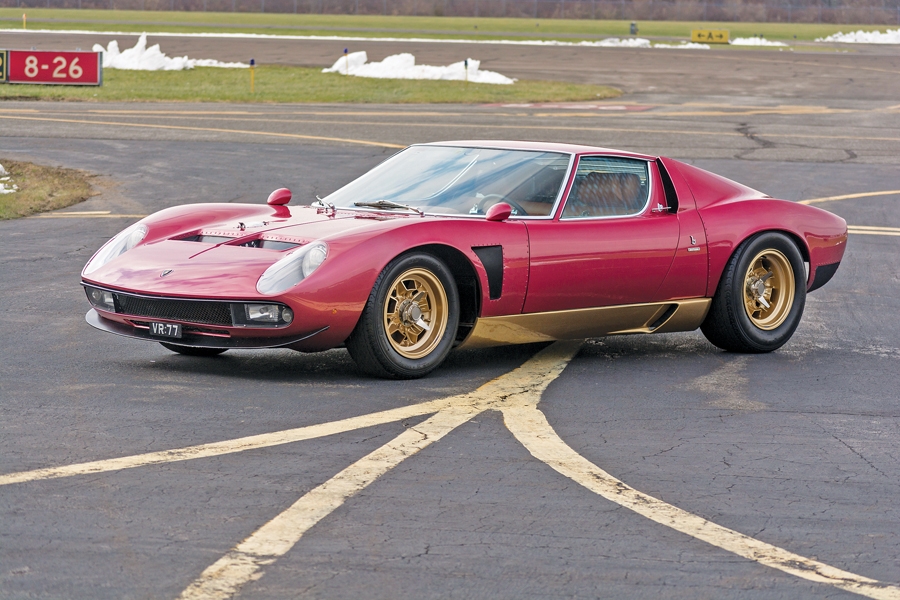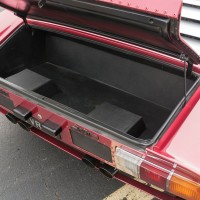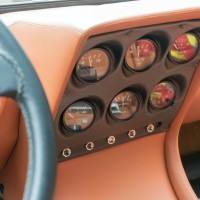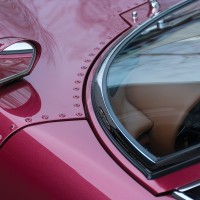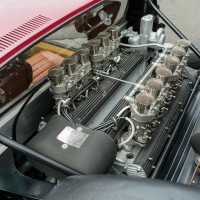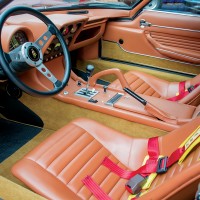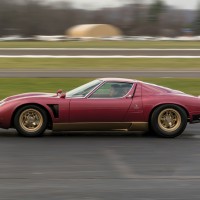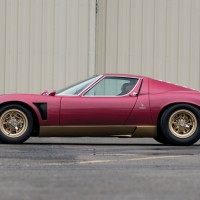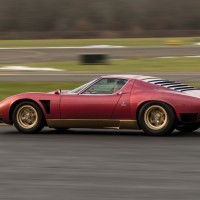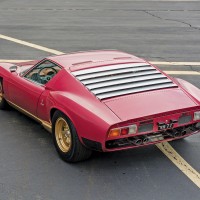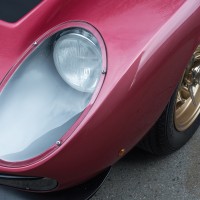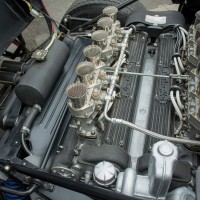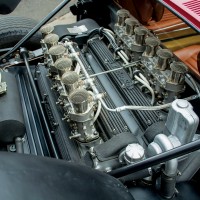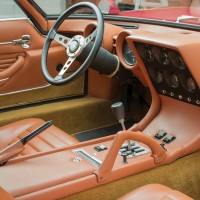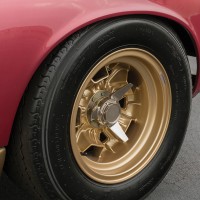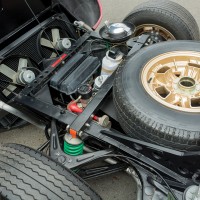Prior to its conversion to Jota specifications, chassis 4892 was constructed at the factory in July 1971 as a Miura SV that was finished in white with a blue interior. The car remained in Italy and was sold new to a Dr. Alcide of Rome, Italy. It is not known when the conversion was done, but a letter issued by Lamborghini in 1974 listed it as a “P400 Miura SV Mod. Jota” at that time, which confirms that the conversion was done within three years following its production.
Mechanically, chassis 4892 received slight engine tuning and was fitted with a wet-sump engine. It was refinished in red at that time and imported to Japan. The car then passed through two subsequent owners before Kazuo Takahashi restored it in the late 1980s. After moving to the United States in 2007, it was purchased by a collector residing in northeastern Pennsylvania. The Miura was then shown at the 2007 William K. Vanderbilt Jr. Concours d’Elegance in Newport, RI, where it earned the Vanderbilt Award.
In May 2007, chassis 4892 was inspected by Claudio Zampolli, a former Lamborghini employee who was in charge of the company’s Special Projects Division from 1967 to 1972. Zampolli confirmed in a letter that this particular car has all the correct features of the factory-modified SV-Jotas, furthering the belief that this is one of the true factory-modified cars. It was then decided that the car would be fully restored by Miura expert Gary Bobileff, a process which took two years and cost $225,000.
The car was acquired by its current custodian in 2010 and has been sparingly driven and expertly maintained and preserved in his custody. The current owner of this Jota also took the time to research the car’s history and contacted Bob Wallace before his passing.
Through this interaction, Wallace was able to confirm that the car was indeed converted to Jota specifications at the factory. The car is still in excellent shape both cosmetically and mechanically, and it would be an ideal acquisition for anyone looking for a Miura that would stand out from the rest. Included with the sale of this car is an extensive file containing letters from Automobili Lamborghini, Claudio Zampolli, and Bob Wallace, as well as restoration photos and documents.
SVJ-specification Miuras are examples of “what could have been” had Lamborghini taken Bob Wallace’s advice and decided to go racing. They are without a doubt some of the most interesting cars to have ever left Sant’Agata. This Miura SVJ, one of only a handful of its kind built as an homage to the original SVJ, is an important part of Lamborghini history, harkening back to a car that was the pinnacle of Lamborghini engineering and development at its time. Any Miura is a beautiful car to behold, either at a standstill or at speed, and this SVJ takes the revered Miura to the next level.
SCM Analysis
Detailing
| Vehicle: | 1971 Lamborghini Miura SVJ |
| Years Produced: | 1967–71 (SV) |
| Number Produced: | 150 (SV) |
| Original List Price: | $18,000 |
| SCM Valuation: | $1.1m to $1.7m |
| Tune Up Cost: | $1,000 |
| Chassis Number Location: | Front crossmember behind radiator, chassis plate on firewall |
| Engine Number Location: | On center of head on top of block |
| Club Info: | Miura Register |
| Website: | http://www.themiuraregister.com |
| Alternatives: | 1970 Iso Grifo S2 7-liter, 1967 Corvette L88, 1971 Ferrari 365 GTB/4 |
| Investment Grade: | A |
This car, Lot 119, sold for $1,897,500, including buyer’s premium, at the RM Auctions sale in Phoenix, AZ, on January 15, 2015.
Many people believe that Brigadoon, unicorns, sasquatch, mermaids and leprechauns really exist, but this doesn’t make mythical creatures and objects real to people who don’t believe.
On the other hand, there are one-off creations, which may inspire duplicates — but those copies are not to be confused with the genuine item. Your neo-classical home may have front and rear porticos and have an address on a street called “Pennsylvania,” but that doesn’t make it the White House. Yes, this is a provocative manner in which to begin a profile of a Lamborghini Miura SVJ, but there you are.
The world knows that there is actually only one Rolls-Royce “Silver Ghost.” The 6-cylinder 40/50-hp cars were named just that, the “40/50,” while a single car, registered AX201, is the “Silver Ghost.” The line took the name retrospectively with the introduction of the Phantom in 1926 — when Rolls-Royce gave in to what everyone had called the car for years. Then there is Ferrari, which — 47 years later — still refuses to refer to the 365 GTB/4 as the “Daytona” in official nomenclature.
One Jota — and several SVJs
There was only one “Jota.” There are a number of modified SVs that are called SVJs. The Jota itself was a one-off sports racing prototype development that Bob Wallace created on non-company time. It had a high-performance dry-sump engine with straight-pipe exhaust.
The Jota also was built around a specially constructed, highly modified tubular frame incorporating lightweight alloy construction, which is very different from the standard box-section platform frame of the production Miuras. Of course, the Jota’s body was also notable for a prominent chin spoiler, which ran up above the front wheelarches to help deal with the Miura’s notorious light front end at speed. The Jota also has various intake and exhaust vents and grilles.
It is well known that Ferruccio Lamborghini had no intention of building race cars, and he had no interest in encouraging his employees or customers to enter his cars in competition. That he hired some of the most talented sports racing car designers to create his GT road cars was apparently beside the point. Lamborghini’s aim was to build the most capable road cars he could — and get rich folks to pay him for the privilege of driving them. He didn’t want to spend his money chasing Ferrari and Porsche at Daytona, the Nürburgring and Spa.
What’s under the skin?
It was — and still is — easy to give a Miura S or SV the cosmetic “Jota” treatment, but how many were actually the recipients of the really key under-the-skin modifications? And of those, exactly which mods were made and to what level?
Given the record keeping at Lamborghini at the time, it’s unlikely that anyone will ever know. Now-retired Lamborghini legend Valentino Balboni was present at our subject car’s sale in Phoenix, so it’s likely that any serious potential bidder would have — or at least should have — sought his counsel on what was present here. As it is, it’s best that the new owner is hopefully satisfied that the car is authentic enough.
There are five SVJ chassis numbers listed in Stefano Pasini’s Lamborghini Catalogue Raisonné 1963–1988, and this car, chassis 4892, is not among them. Our subject car is, however, listed as one of six “factory” SVJs on the International Lamborghini Registry (www.lamborghiniregistry.com), which also lists another 13 cars as having “some SVJ upgrades after production.”
Our subject car was also accompanied by the letter from Claudio Zampolli mentioned in the catalog — and by testimony from Bob Wallace — which indicated that it was consistent with the correct mods for an SVJ and that it could have been factory built, respectively. It’s worth noting that the actual details of the modifications to this particular car are not given, so it’s difficult to tell the level of spec on offer here.
I know from personal experience, having owned a 1969 Lamborghini Islero, that Italian factory records — even when they exist — can be frustratingly vague and even incorrect. I had in my possession an original carbon copy of the pro forma invoice for my car from the factory to U.S. importer Bob Estes, indicating sale and shipment to California. At the same time, the files in Sant’Agata Bolognese showed a document confirming the same chassis being delivered new to the dealer in Rome, Italy.
A great car in any light
As the Lamborghini factory regularly “updated” cars in routine servicing for customers in period, there’s nothing unsavory, suspicious or unacceptable about a Jota-spec Miura. Like an Abarth Fiat, which could have come from the factory complete or been massaged by your local Fiat dealer or corner garage, the deciding factors are how many goodies are fitted, the quality of the bits and how well they’ve been integrated. You do your research, make a decision and live with it.
A Miura P400 is a remarkable machine, an S more so and an SV very much so. Anything beyond that paints the lily as far as I’m concerned, but then there are many for whom too much of a good thing can’t be, even if it never existed in the first place. The price was a big one to be sure, but not an auction record for the Miura, which is currently held by a stunning 1971 SV with a then-four-year-old restoration sold by RM Auctions in Monterey in August 2014 for $2,090,000. That result puts this sale into a bit better context. ♦
(Introductory description courtesy of RM Auctions.)
